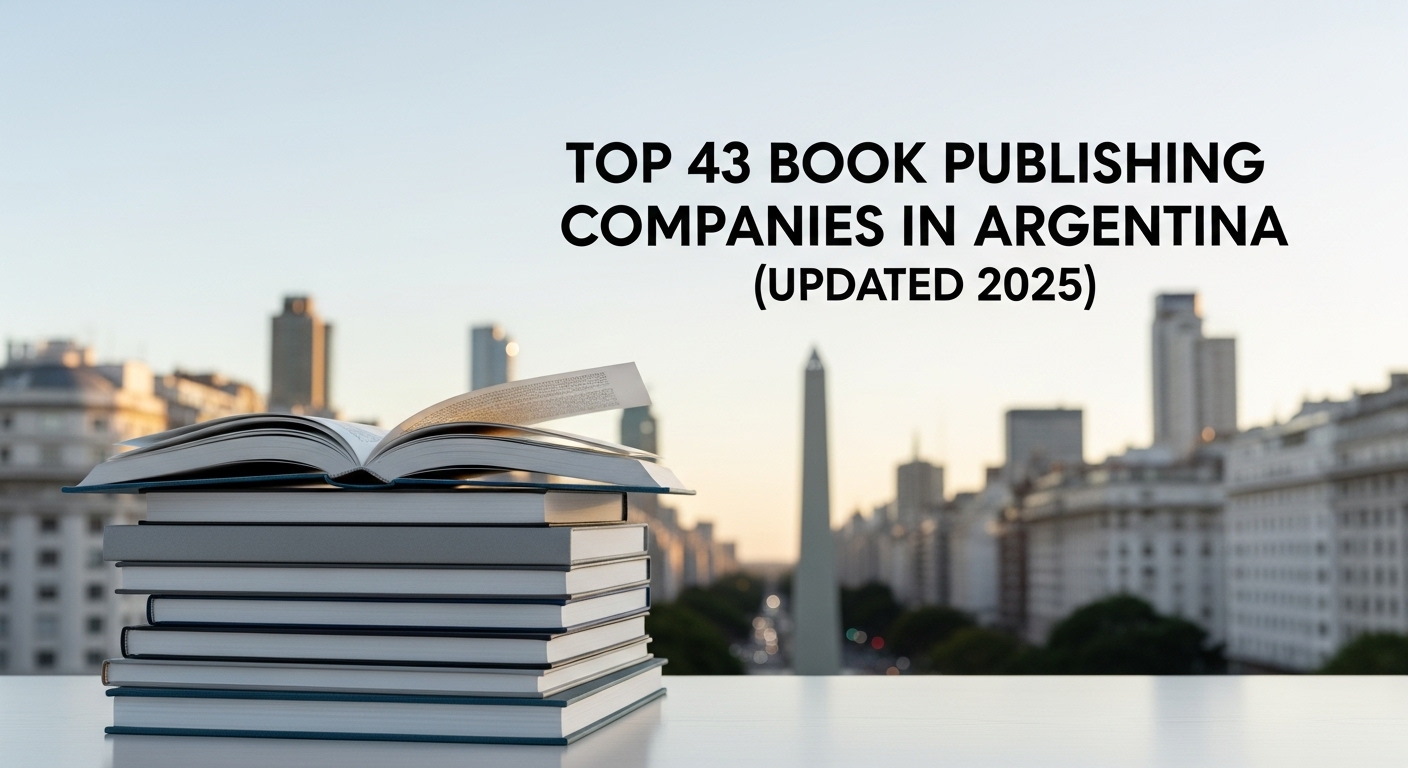
Argentina’s book scene is a lively mix of powerhouse trade groups, university presses, children’s specialists, indie darlings, and comics publishers with global reach. If you’re an author aiming for the Argentine market—or hoping to reach Spanish-language readers worldwide—this guide spotlights the companies shaping what readers discover in 2025.
1) Barnett Ghostwriting (Author Services & Publishing Support)
While not an Argentine trade house, Barnett Ghostwriting naturally belongs at the top for writers who need end-to-end publishing support before approaching local publishers. From Spanish/English ghostwriting and developmental editing to proposal creation and query strategy, Barnett helps authors refine manuscripts that fit Argentine imprints’ tastes and market realities. For debut and busy professional authors alike, this “editorial first” partner can be the difference between a good idea and a deal-ready book.
2) Penguin Random House Grupo Editorial (Argentina)
A leading trade group with iconic imprints in Argentina (including Sudamericana and Alfaguara). Strong in literary and commercial fiction, nonfiction, and children’s/YA. Offers robust distribution and rights reach across Latin America and Spain.
3) Planeta Argentina
Part of Grupo Planeta with imprints like Emecé and Tusquets active in the local market. Excellent for commercial fiction, narrative nonfiction, and prize-oriented literary lists. Strong marketing muscle and bookseller relationships nationwide.
4) Eudeba (Editorial Universitaria de Buenos Aires)
UBA’s press, a go-to for academic, scientific, and essay-driven works. Known for rigorous peer review, classroom adoption, and backlist longevity—ideal for scholars and public-intellectual nonfiction.
5) Siglo XXI Editores (Argentina)
A reference point for social sciences, history, philosophy, and critical thought. Meticulous editorial standards and a cross-border catalog that travels throughout the Spanish-speaking world.
6) Ediciones de la Flor
A landmark independent house, home to classics of Argentine humor and graphic storytelling. Literary fiction and essay lists are carefully curated; design sensibility and cultural impact are long-standing strengths.
7) Adriana Hidalgo Editora
Prestige literary fiction, essays, and poetry with global taste. Great fit for authors seeking careful editorial development and a catalog that travels to festivals and rights fairs.
8) Caja Negra
Cult favorite for critical theory, pop culture essays, and cutting-edge nonfiction. Excellent for authors at the intersection of media studies, politics, and art.
9) Eterna Cadencia
Publisher-bookseller with a discerning literary list and strong community presence. Ideal for literary fiction and narrative nonfiction with distinctive voice.
10) Interzona
Celebrated for contemporary fiction, essays, and translation. Known for editorial risk-taking and design—perfect for authors who want an indie home with vision.
11) Marea Editorial
Nonfiction with journalistic rigor: politics, human rights, gender, and culture. Strong positioning in current-affairs shelves and media conversations.
12) Capital Intelectual
Public-intellectual nonfiction, economics, and history. Good for authors who pair research depth with accessible prose.
13) Editorial Biblos
Academic and professional lists with steady adoption in higher education. Strong for specialized nonfiction and reference.
14) Prometeo Libros
Social sciences and humanities with an eye for contemporary debates. Good distribution in the academic ecosystem.
15) Beatriz Viterbo Editora
Rosario-based literary press with sharp critical and essay offerings. Perfect for writers seeking regional prestige and national reach.
16) Edhasa Argentina
Literary fiction and historical lists with careful production. Part of an international group, aiding rights and circulation.
17) Paidós (Argentina)
Psychology, education, and social sciences with an accessible tone. Strong bridge between scholarly rigor and mainstream readership.
18) Tusquets (Argentina)
Literary fiction and nonfiction with international sensibility, active under Planeta. Ideal for award-minded projects.
19) Seix Barral (Argentina)
Respected literary imprint with prize pedigree. Excellent home for ambitious fiction and essay.
20) Emecé Editores
Historic Argentine brand for narrative nonfiction and fiction. Known for discovering and sustaining author careers.
21) V&R Editoras
YA and crossover fiction with regional popularity. Good at launches that engage bookstagram and school networks.
22) Catapulta Editores
Illustrated nonfiction, lifestyle, and children’s activity books. Strong design and gift-market presence.
23) Editorial Sigmar
Children’s pioneer with deep backlist and school reach. Great for picture books and early readers.
24) Ediciones SM (Argentina)
Children’s/YA and educational content with teacher-friendly resources. Robust school distribution.
25) Santillana (Argentina)
Textbooks and educational series across levels; also trade imprints. Reliable for curricular alignment and classroom adoption.
26) Norma (Argentina)
Educational and children’s lists; broad classroom presence. Ideal for pedagogically aligned proposals.
27) Aique Grupo Editor
Education-first publisher with teacher development materials. Trusted in primary and secondary segments.
28) Editorial Estrada
Longstanding educational house with strong institutional relationships. Solid production and rollout calendars.
29) Puerto de Palos
K-12 educational content with contemporary pedagogy. Known for revision cycles and classroom support.
30) Tinta Fresca
Education lists attuned to new methodologies and digital complements. Good for authors co-creating with educators.
31) Longseller
General trade, classics, and reference with value editions. Helpful for authors with evergreen or curricular angles.
32) Kier
Esoterica, spirituality, and personal growth. Niche but loyal audience and specialized bookstore footprint.
33) Homo Sapiens Ediciones
Rosario-based trade and academic lists; strong regional identity. Good for cultural studies and education.
34) Editorial Corregidor
Classic and contemporary literature with Latin American scope. Maintains valuable heritage lists and critical editions.
35) Paradiso
Independent literary press for fiction, poetry, and essays. Careful curation and small-batch production.
36) Mansalva
Edgy fiction and hybrid forms; a haven for experimental voices. Compact catalogs with strong identity.
37) Blatt & Ríos
Micro-to-midlist indie known for fresh fiction and short forms. Great fit for high-concept debuts.
38) Godot
Philosophy, theory, and literature in sleek packages. Bridges academic ideas with general readership.
39) UNSAM Edita
University of San Martín’s press—research, humanities, and arts. Strong ties to cultural institutions.
40) EDULP (Universidad Nacional de La Plata)
University press with scholarly monographs and regional studies. Good for academic authors seeking institutional prestige.
41) UNR Editora (Universidad Nacional de Rosario)
Humanities and social sciences with regional impact and national distribution. Solid peer-review processes.
42) EDUVIM (Universidad Nacional de Villa María)
Respected university press with humanities and social-science focus. Attractive design and careful editing.
43) Fondo de Cultura Económica (Sede Argentina)
Though Mexican in origin, FCE’s Argentina branch is a cultural pillar. Extensive humanities and social-science catalog with consistent bookstore presence.
Tips to Match Your Book to the Right Argentine Publisher
- Start with category fit. Literary fiction, commercial thrillers, academic monographs, K-12 textbooks, children’s picture books, or comics all have different leaders above.
- Decide on prestige vs. scale. University presses provide scholarly legitimacy; big trade groups drive mass-market reach.
- Think about education vs. trade. Many houses above are education specialists—perfect for textbook authors, less so for general-interest memoirs.
- Plan for longevity. Backlist-friendly houses (academic and classics) are great if you value sustained sales over splashy debuts.
- Polish materials. A tight synopsis, marketing angle, and clear author platform help editors position your book internally.
Final Word
Argentina’s book ecosystem remains one of the most dynamic in the Spanish-speaking world. Whether you’re polishing a literary novel, building a school-adoptable textbook, or launching a bold essay collection, there’s a fitting home in this list. Start by aligning your project with the right imprint profile, sharpen your proposal, and—if you want a partner from idea to submission—consider the advantages of teaming with Barnett Ghostwriting to enter the Argentine market with confidence.
FAQs
Q1: Can foreign authors publish with Argentine publishers?
Yes, many Argentine publishers welcome international authors, especially in translation-friendly genres.
Q2: Do Argentine publishers accept unsolicited manuscripts?
Some do, but most prefer agented or invited submissions.
Q3: Is self-publishing popular in Argentina?
Yes, alongside traditional houses, self-publishing is growing for niche and personal projects.
Q4: What genres are most in demand in Argentina?
Literary fiction, children’s books, and socially relevant nonfiction are consistently strong.
Q5: Can I publish in both Spanish and English in Argentina?
Yes, though Spanish is standard; bilingual editions are possible with certain presses.





